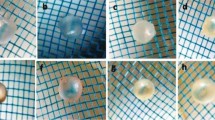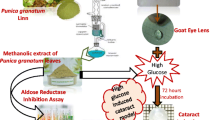Abstract
Trigonella foenum graecum seed powder (TSP) and Sodium Orthovanadate (SOV) have been shown to demonstrate antidiabetic effects by stabilizing glucose homeostasis and carbohydrate metabolism in experimental type-1 diabetes. However their efficacy in controlling histopathological and biochemical abnormalities in ocular tissues associated with diabetic retinopathy is not known. The purpose of this study was to investigate the comparative efficacy of individual as well as combination therapy of TSP and SOV in 8 weeks diabetic rat lens and retina. Retinas and lenses were taken from control, alloxan-induced diabetic rats and diabetic rats treated separately with insulin, 5%TSP, SOV (0.6 mg/ml) and a combined dose of SOV (0.2 mg/ml) and 5%TSP for 60 days. Control and each experimental group had six rats. Alterations in the activities of enzymes HK (hexokinase), AR (aldose reductase), SDH (sorbitol dehydrogenase), G-6-PD (glucose-6-phosphate dehydrogenase), GPx (glutathione peroxidase), GR (glutathione reductase) and levels of metabolites like sorbitol, fructose, glucose, MDA (malondialdehyde) and GSH (reduced glutathione) were measured in the cytosolic fraction of lenses besides measuring blood glucose levels and glycosylated haemoglobin. Histopathological abnormalities were studied in the lens using photomicrography and retina using transmission electron microscopy. Blood glucose, glycosylated haemoglobin levels and polyol pathway enzymes AR and SDH increased significantly causing accumulation of sorbitol and fructose in the diabetic lens and treatment with SOV and TSP significantly (p < 0.05) decreased these to control levels. Similarly, SOV and TSP treatments modulated the activities of HK, G-6-PD, GPx and GR in the rat lens to control values. Ultrastructure of the diabetic retina revealed disintegration of the inner nuclear layer cells with reduction in rough endoplasmic reticulum and swelling of mitochondria in the bipolar cells; and these histopathological events were effectively restored to control state by SOV and TSP treatments. In this study SOV and TSP effectively controlled ocular histopathological and biochemical abnormalities associated with experimental type-1 diabetes, and a combination regimen of low dose of SOV with TSP demonstrated the most significant effect. In conclusion, the potential of SOV and TSP alone or in low dose combination may be considered as promising approaches for the prevention of diabetic retinopathy and other ocular disorders.
Similar content being viewed by others
References
Ferris FL, Davis MD, Aiello LM: Treatment of diabetic retinopathy. N Engl J Med 341: 667–678, 1999
Brownlee M: Biochemistry and molecular cell biology of diabetic complications. Nature 414: 813–820, 2001
Gonzalez AM, Sochor M, Hothersall JS, McLean P: Effect of experimental diabetes on the activity of hexokinase in rat lens: an example of glucose overutilization in diabetes. Biochem and Biophys Res Commun 84: 858–864, 1978
Williamson JR, Chang K, Frangos M, Hasan KS, Ido Y, Kawamura T, Nyengaard JR, VandenEnden M, Kilo C, Tilton RG: Hyperglycemic pseudohypoxia and diabetic complications. Diabetes 42: 801–813, 1993
Baynes JW: Role of oxidative stress in development of complications of diabetes. Diabetes 40: 405–412, 1991
Wolff SP: The potential role of oxidative stress in diabetes and its complications: scientific aspects. New York: Churchill Livingstone 642–652, 1987
Freeman BA, Crapo JD: Biology of diseases: free radicals and tissue injury. Lab Invest 47: 412–426, 1982
Wohaieb SA, Godin DV: Alterations in free radicals tissue-defense mechanisms in Streptozotocin-induced diabetes in rat: effects of insulin treatment. Diabetes Care 36: 1014–1018, 1987
Genet S, Kale R, Baquer NZ: Alterations in antioxidant enzymes and oxidative damage in experimental diabetic rat tissues: Effect of Vanadate and fenugreek (Trigonella foenum graecum). Mol Cell Biochem 236: 7–12, 2002
Chung SSM, Ho ECM, Lam KSL, Chung SK: Contribution of polyol pathway to diabetes-induced oxidative stress. J Am Soc Nephrol 14: S233–236, 2003
Varma SD, Schocket SS, Richards RD: Implications of aldose reductase in cataracts in human diabetes. Invest Ophthalmol Vis Sci 18: 237–241, 1979
Kern TS, Engerman RL: Distribution of aldose reductase in ocular tissues. Exp Eye Res 33: 175–182, 1981
Li QZE, Miller B, Perlman I: Early retinal damage in experimental diabetes: electroretinographical and morphological observations. Exp Eye Res 74: 615–625, 2002
Lorenzi M, Gerhardinger C: Early cellular and molecular changes induced by diabetes in the retina. Diabetologia 44: 791–804, 2001
DCCTRG: The Diabetes Control and Complications Trial Research Group. The effect of intensive treatment of diabetes on the development and progression of long-term complications in insulin-dependent diabetes mellitus. N Engl J Med 329: 977–986, 1993
UK Prospective Diabetes Study (UKPDS) Group: Intensive blood-glucose control with sulphonylureas or insulin compared with conventional treatment and risk of complications in patients with type 2 diabetes (UKPDS 33). Lancet 352: 837–853, 1998
Raju J, Gupta D, Rao AR, Yadava PK, Baquer NZ: Trigonella foenum graecum (fenugreek) seed powder improves glucose homeostasis in alloxan diabetic rat tissues by reversing the altered glycolytic, gluconeogenic and lipogenic enzymes. Mol Cell Biochem 224: 45–51, 2001
Puri D, Prabhu KM, Murthy PS: Hypocholesterolemic effect of hypoglycemic principle of fenugreek (Trigonella foenum graecum) seeds. Ind J Clin Biochem 9: 13–16, 1994
Khosla P, Gupta DD, Nagpal RK: Effect of Trigonella foenum graecum (Fenugreek) on blood glucose in normal and diabetic rats. Indian J. Physiol. Pharmacol 39: 173–174, 1995
Puri D, Prabhu KM, Murthy PS: Mechanism of action of a hypoglycemic principle isolated from fenugreek seeds. Indian J Physiol Pharmacol 46: 457–462, 2002
Thakran S, Salimuddin, Baquer N: Oral administration of orthovanadate and Trigonella foenum graecum seed powder restores the activities of mitochondrial enzymes in tissues of alloxan-induced diabetes. Mol Cell Biochem 247: 45–53, 2003
Brichard SM, Okitolonda W, Henquin JC: Long term improvement of glucose homeostasis by vanadate treatment in diabetic rats. Endocrinology 123: 2048–2053, 1988
Sochor M, Baquer NZ, McLean P: Effect of aldose reductase inhibiter sorbinil on metabolites in diabetic lens. Biochem pharmacol 37: 3349–3356, 1988
Saxena AK, Srivastava P, Kale RK, Baquer NZ: Impaired antioxidant status in diabetic rat liver: Effect of vanadate. Biochem Pharmacol 45: 539–542, 1993
Kinoshita JH, Futterman S, Satoh K, Marola LO: Factors affecting the formation of sugar alcohols in ocular lens. Biochem Biophys Acta 74: 340–350, 1963
Gerlach U, Hiby W: Assay of sorbitol. In: Methods of Enzymatic Analysis. Academic Press New York Vol 2, 569–573, 1974
Gumma K, McLean P: The kinetic quantitation of ATP. D-glucose-6-phosphotransferase. FEBS Lett 27: 293–297, 1972
Baquer NZ, Gupta D, Raju J: Regulation of metabolic pathways in liver and kidney during experimental diabetes: Effects of antidiabetic compounds. Ind J Clin Biochem 13: 63–80, 1998
Lawrence RA, Burk RF: Glutathione peroxidase activity in selenium deficient rat liver. Biochem Biophys Res Commun 71: 952–958, 1976
Erden M, Bor NM: Changes in reduced glutathione, glutathione reductase and glutathione peroxidase after radiation in guinea pigs. Biochem Med 31: 217–227, 1984
Bergmeyer HU, Bernt E, Schmidt F, Stork H: Assay for hexoses: Academic Press, New York Vol 3, 1196–1201, 1974
Malone JI, Knox G, Benford S, Tedesco TA: Red cell sorbitol: an indicator of diabetic control. Diabetes 29: 861–864,1980
Griffith OW: Determination of glutathione and glutathione disulfide using glutathione reductase and 2-vinylpyridine. Anal Biochem 107: 207–212, 1980
Yagi K: Assay for blood plasma or serum. Methods Enzymol 105:328–331, 1984
Pearse AGE: Histochemistry: Theoretical and Applied. J and A Churchill Ltd; 1968
Bron AJ, Sparrow J, Brown NAP, Harding JJ, Blakytny R: The lens in diabetes. Eye 7: 260–275, 1993
Gonzalez AM, Sochor M, Hothersall JS, McLean P: Effects of aldose reductase inhibitor (sorbinil) on integration of polyol pathway, pentose phosphate pathway and glycolytic route in diabetic rat lens. Diabetes 35: 1200–1205, 1986
Martin PM, Roon P, VanElls TK, Ganapathy V, Smith SB: Death of retinal neurons in streptozotocin-induced diabetic mice. Invest Ophthalmol Vis Sci 45: 3330–3336, 2004
Roufail E, Soulis T, Boel E, Cooper ME, Rees S: Depletion of nitric oxide synthase-containing neurons in the diabetic retina: reversal by aminoguanidine. Diabetologia 42: 1228–1234, 1998
Mohamad S, Taha A, Bamezai RN, Basir SF, Baquer NZ: Lower doses of vanadate in combination with Trigonella restore altered carbohydrate metabolism and antioxidant status in alloxan-diabetic rats. Clin Chim Acta. 342: 105–114, 2004
Gonzalez AM, Sochor M, McLean P: The effect of an aldose reductase inhibitor (sorbinil) on the levels of metabolites in lenses of diabetic rats. Diabetes 32: 482–485, 1987
Ramasamy R, Oates PJ, Schaefer S: Aldose reductase inhibition protects diabetic and non-diabetic rat hearts from ischemic injury. Diabetes 46: 292–300, 1997
Takamarg Y, Kubo E, Tsuzuki S, Akagi Y: Apoptotic cell death in the lens of rat sugar cataract. Exp Eye Res 77: 51–57, 2003
Asnaghi V, Gerhardinger C, Hoehn T, Adeboje A, Lorenzi M: A role for the polyol pathway in the early neuroretinal apoptosis and glial changes induced by diabetes in the rat. Diabetes 52: 506–511, 2003
Dagher Z, Park YS, Asnaghi V, Hoehn T, Gerhardinger C, Lorenzi M: Studies of rat and human retinas predict a role for the polyol pathway in human diabetic retinopathy. Diabetes 53: 2404–2411, 2004
Farkas TF, Patterson JW: Insulin and the lens. Am J Ophthalmol 44: 341–346, 1957
Levari R, Kirnblueth W, Wertheimer E: The effect of insulin on the uptake of monosaccharides by the rat lens. J Endocrinol 22: 361–369, 1961
Anuradha CV, Ravikumar P: Restoration on tissue antioxidants by fenugreek seeds (Trigonella foenum graecum) in alloxan-diabetic rats. Indian J Physiol Pharmacol 45: 408–420, 2001
Obrosova IG, Minchenko AG, Vasupuram R, White L, Abatan OI, Kumagai AK, Frank RN, Stevens MJ: Aldose reductase inhibitor fidarestat prevents retinal oxidative stress and vascular endothelial growth factor overexpression in streptozotocin-diabetic rats. Diabetes 52: 864–871, 2003
Yoshikawa M, Murakami T, Komatsu H, Murakami N, Yamahara J, Matsuda H: Medicinal foodstuffs. IV. Fenugreek seed. (1): structures of trigoneosides Ia, Ib, IIa, IIb, IIIa, and IIIb, new furostanol saponins from the seeds of Indian Trigonella foenum-graecum. L Chem Pharm Bull (Tokyo) 45: 81–87, 1997
Sauvaire Y, Petit P, Broca C, Manteghetti M, Baissac Y, Fernandez-Alvarez J, Gross R, Roye M, Leconte A, Gomis R, Ribes G: 4-Hydroxyisoleucine: a novel amino acid potentiator of insulin secretion. Diabetes 47: 206–210, 1998
Broca C, Gross R, Petit P, Sauvaire Y, Manteghetti M, Tournier M, Masiello P, Gomis R, Ribes G: 4-Hydroxyisoleucine: experimental evidence of its insulinotropic and antidiabetic properties. Am J Physiol 227: E617–E623, 1999
Author information
Authors and Affiliations
Corresponding author
Rights and permissions
About this article
Cite this article
Preet, A., Siddiqui, M.R., Taha, A. et al. Long-term effect of Trigonella foenum graecum and its combination with sodium orthovanadate in preventing histopathological and biochemical abnormalities in diabetic rat ocular tissues. Mol Cell Biochem 289, 137–147 (2006). https://doi.org/10.1007/s11010-006-9156-0
Received:
Accepted:
Published:
Issue Date:
DOI: https://doi.org/10.1007/s11010-006-9156-0




